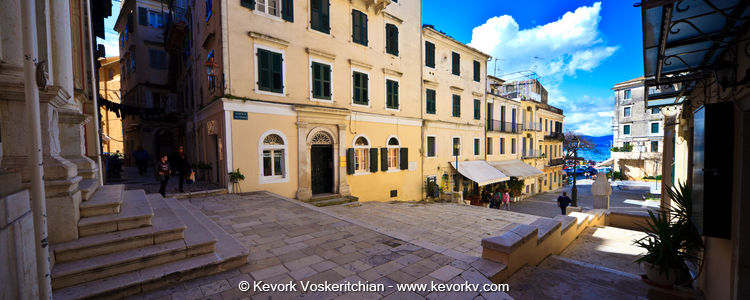


Liston

If you are in Corfu it is a must to have a cup of traditional Greek coffee in one of cafeterias of Liston. The notions “low” or “high” seasons do not apply to this street which is crowded any time of the year. And it is a real pleasure to relax in the shade of its arches with all the beauty of Spianada Square lying in front of you. Initially Liston was constructed as protection for Spianada before the residential quarters had been built. The building of Liston were construed by the Royal French between 1807 and 1814. Its ground floor served as barracks for soldiers and the first floor for the officers. The other floors were built later. The French were intending to build arched houses up to the end of the Spianada Square but their plans could not be realized as they had to hand over Corfu to the British.
Ioanian Academy

formerly the Grimani Barracks, this building became, in 1824, the home of the first Greek university. When this closed down, the building was used as the Municipal Library, but it was destroyed by incendiary bombs on September 14th 1943, during an Italian air raid. It has now been restored, and houses school and university premises.
Ioanian Parliament
A neo-classical style building with a Doric entrance, built in 1855 by the architect John Chronis, it stands at the top of Moustoxidi Street. On each side of the main entrance are two marble plaques inscribed in Greek and English, commemorating the vote which resulted in the unification of the Ionian Islands with Greece.

Kapodistrias Mansion

Palace of St. Michael & George
Also knows as the City Palace, designed by Sir George Whitmore and built of Maltese stone between 1814 and 1824, in Georgian style under the first Lord High Commissioner Sir Thomas Maitland it became the official seat of the Commissioner. It has two wings, dedicated to the Archangel Michael and Saint George, and the main entrance which looks towards the square is fronted by a colonnade in Doric style.

Town Hall

The first theater in Greece was found in Corfu and was named “Nobile Teatro di San Giacomo” as it was situated at the square next to the Catholic Cathedral San Giacomo. Today the building once accommodating the theater serves as the Town Hall of Corfu. The construction of the building started in 1663 and initially was intended to be used as a place where for nobles to arrange their meetings and entertaining events. In 1720 it was transformed into a theater which was functioning in accordance with European specifications. A lot of legendary operas and plays were staged here. The building was designed by an unknown architect and constructed from carved Siniotic stone with lavish decorations and baroque sculptures.


© 2016 All CopyRights Reserved
All content is copyrighted, no part my be copied, or used, for any reason, without the prior written agreement.
Any and all copyright violation will be legally prosecuted.
Magestic Buildings


There are very few places in Greece, Athens included, were you can find so many grand buildings in such a small area. Starting from the Palace of St. Michael and St. George, moving on to Liston, most of the buildings around the coastline of Mouragia and Faliraki, the Town Hall, Alexandras Ave., Mon Repo, select parts of Kanoni, Villa Rosa, the list goes on and on.
Yes the island has been occupied by the Venetians, the British, the French, the Austrians over hundreds of years, but so have many other places in Greece, why Corfu has so much to show for ?
The first reason is rather obvious, it was and still is such a nice place to live, so it attracted the rich and famous who built all these wonderful buildings, the Achillion palace is perhaps the finest example of royalty wanting to live here. Corfu was also a famous rehabilitation destination, especially for people with breathing disorders and not only.
But there are another couple of reasons why so much has survived over the centuries. Those intimidating fortress all around the island kept many invaders out, in particular the Ottomans, renowned for the devastations they left behind them where ever they went.
The other reason is the lack of any major earthquakes, which cannot be said for neighboring Kefalonia and Zakynthos. Although small quakes are not uncommon, there has not been a destructive earthquake for a very long time. Despite some significant losses during the second World war Corfu still has more to show for than any other Greek island.
So it should come as no surprise that the entire old city is now a UNESCO World Heritage Site.
Yes the island has been occupied by the Venetians, the British, the French, the Austrians over hundreds of years, but so have many other places in Greece, why Corfu has so much to show for ?
The first reason is rather obvious, it was and still is such a nice place to live, so it attracted the rich and famous who built all these wonderful buildings, the Achillion palace is perhaps the finest example of royalty wanting to live here. Corfu was also a famous rehabilitation destination, especially for people with breathing disorders and not only.
But there are another couple of reasons why so much has survived over the centuries. Those intimidating fortress all around the island kept many invaders out, in particular the Ottomans, renowned for the devastations they left behind them where ever they went.
The other reason is the lack of any major earthquakes, which cannot be said for neighboring Kefalonia and Zakynthos. Although small quakes are not uncommon, there has not been a destructive earthquake for a very long time. Despite some significant losses during the second World war Corfu still has more to show for than any other Greek island.
So it should come as no surprise that the entire old city is now a UNESCO World Heritage Site.

















































































































